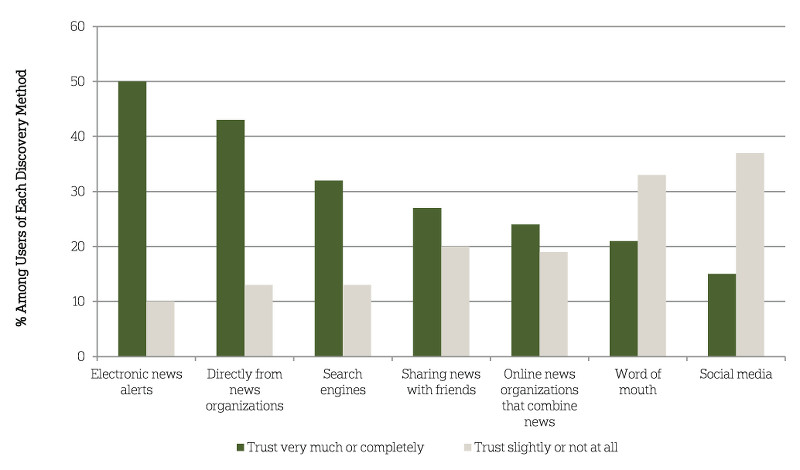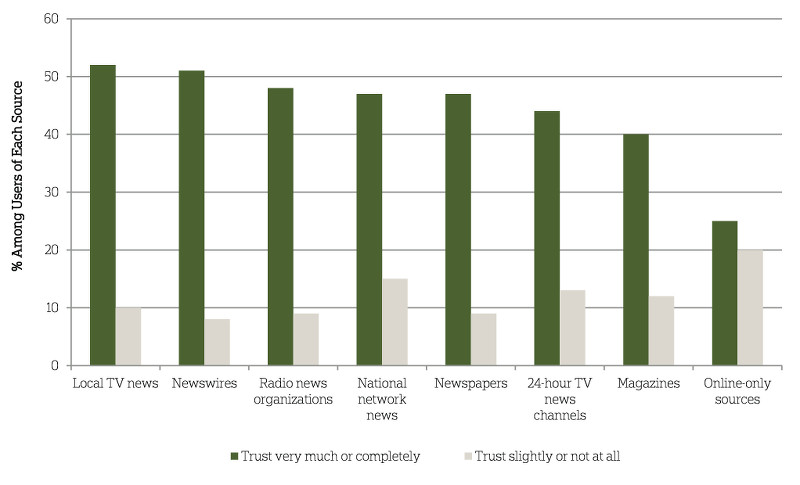Americans are accessing the news throughout the day and across devices
For many Americans, keeping up with the news is an activity that occurs throughout the day and across different formats, devices, and technologies. When asked when they prefer to watch, read, or hear news, a plurality (33 percent) report following the news all throughout the day. A smaller but sizable number of Americans continue to prefer to follow the news in the morning (24 percent) and in the evening (26 percent), while still lesser numbers say they most often get news in the afternoon (4 percent) and right before bed (9 percent).
Is there a particular time that people go for more in-depth news, beyond the headlines? Overall, 4 in 10 Americans report that they delved deeper into a particular news subject beyond the headlines in the last week. When they did, that in-depth reading, watching, or listening followed a similar pattern to news consumption generally, with a plurality (34 percent) saying there is no particular time they prefer to read in-depth news. That finding challenges the notion that while Americans may get headlines continuously, they reserve the evening for learning more.
In addition, a slightly larger number, 49 percent of adults, said they delved deeper to learn more about the last breaking news story they paid attention to, though time of day was not probed for this, given that news may break at any time.
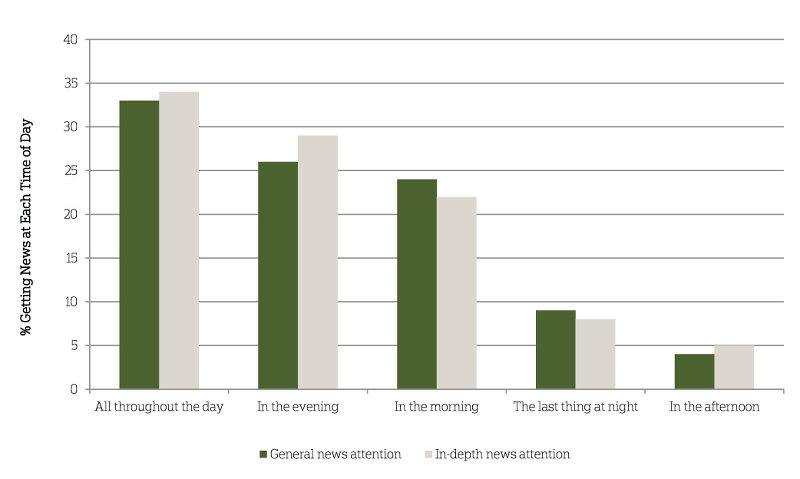
Questions: People can watch, read, or hear in-depth news stories at different times of the day. Would you say you mostly watch, read or hear in-depth stories, beyond the headlines…in the morning, in the afternoon, in the evening, the last thing at night, or all throughout the day?
In general, would you say you prefer to watch, read or hear news in the morning, in the afternoon, in the evening, the last thing at night, or all throughout the day?
Americans follow the news on a wide variety of devices, including through television, radio, print versions of newspapers and magazines, computers, cell phones, tablets, e-readers, and devices such as an Xbox or Playstation that link the internet to a television. Americans on average reported that, during the past week, they followed the news using four different devices or technologies. The most frequently utilized devices include television (87 percent), laptops/computers (69 percent), radio (65 percent), and print newspapers or magazines (61 percent).
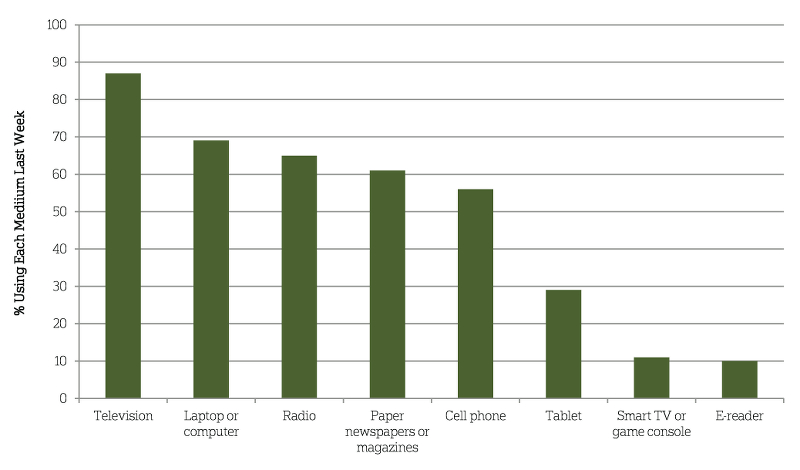
Question: Please tell me if you used each device or technology to get new in the last week, or if you did not.
Among all adult Americans, 56 percent reported using a cell phone and 29 percent reported using a tablet to access news in the last week. (That represents 78 percent of the 69 percent Americans who own a smartphone, and 73 percent of the 39 percent of Americans who own or use a tablet device).
Only 10 percent of Americans reported using an e-reader to get their news in the last week and 11 percent reported using a Smart TV to follow the news in the last week.
Traditional media remain important even for those Americans with the most gadgets. People who own and use more devices are no more or less likely to use print publications, television, or radio to access the news. For example, 62 percent of people who use only one internet enabled device say they used the print version of a publication to get news in the last week, as do 60 percent of those who use three or more mobile devices.
However, as the number of devices a person owns increases, they are more likely to report that they enjoy keeping up with the news and are more likely to say that it’s easier to keep up with the news today than it was five years ago.
In addition to asking Americans about all the devices they use to get the news, the survey asked what device or technology people prefer most. Television was most popular (24 percent), followed by desktop or laptop computer (12 percent), cell phone (12 percent), and tablet computer (4 percent).
The largest group, 45 percent of Americans indicate that they have no preference in the device or technology they use to follow the news. This suggests that many Americans prefer to receive news across devices, using whatever device or technology is most convenient when they want to follow the news.
People use a number of different tools to find out about the news, but trust some more than others
Regardless of the device used, people find or discover news through different means—from old- fashioned word-of-mouth to electronic alerts and social media. The survey reveals that most Americans are discovering news in more than one way. More than half of all Americans report using between three and five methods of discovery to find out about the news (the average across all respondents was between three and four different methods in the last week [mean =3.8]).
The most popular way that Americans report finding their news is directly from a news organization, such as a newspaper, TV newscast, website, or newswire (88 percent). People continue to discover news through traditional word-of- mouth (65 percent) either in person or over the phone, and do so at higher rates than more modern methods of sharing like email, text message, or other ways online (46 percent), or social media (44 percent). And roughly half of Americans said they got news in the last week from search engines and online news aggregators (51 percent for each).
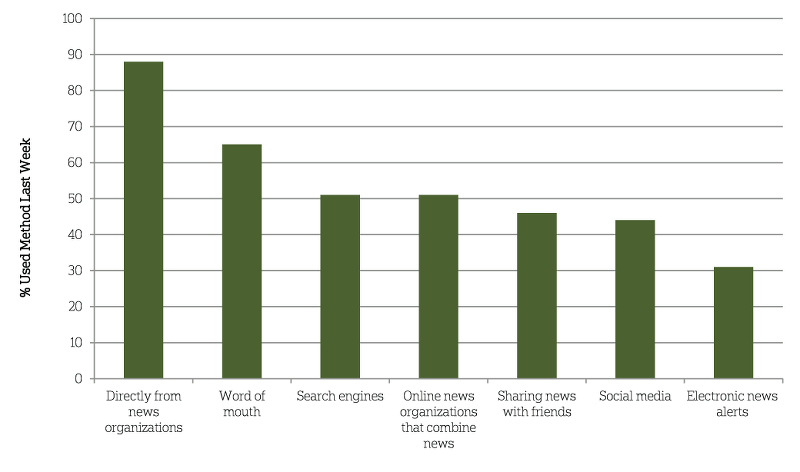
Question: Did you find news in any of the following ways in the last week, or did you not find news in that way?
But while Americans are discovering news through a variety of means, they are discriminating in how much trust they have in the information they get from each method.
Americans trust the news they hear directly from news-gathering organizations, with 43 percent of people saying they trust the information acquired this way either very much or completely, 44 percent saying they trust it moderately, and 13 percent saying they only trust it slightly or not at all.
Between discovering news through aggregators or search engines, Americans who use them say they have more faith in search engines. In all, 32 percent who get news via search say they trust the information they provide either very much or completely compared to just 24 percent who use news aggregators.
And generally, levels of trust in the news discovered through sharing — either verbally or electronically — are low. Just 27 percent say they trust a good deal (very much or completely) the information they receive through electronic sharing with friends, and 21 percent have similar levels of trust for information they receive by word-of-mouth.
Similarly, while social media is becoming an important means of discovering news, even those who use it bring some skepticism to it. Only 15 percent of adults who get news through social media say they have high levels of trust in information they get from that means of discovery. Social media and word-of-mouth are the least-trusted means of discovering the news, with 37 percent of those who got news this way in the last week mistrusting or trusting only slightly social media and 33 percent mistrusting word-of-mouth.
Less than one-third (31 percent) of Americans report that they discovered the news in the last week through electronic news alerts or subscriptions they’ve signed up for (more Americans, 47 percent, report that they ever receive news alerts through text, email, or apps), but they trust this information at higher rates (50 percent) than any other discovery method. Most people who get news from electronic news alerts (92 percent) also report getting information directly from news organizations that report the news.
The survey data also show the powerful connection between the growth in mobile internet technology and social media. Those adults with a cell phone that connects to the internet are much more likely than those without one to find news through social media (56 percent vs. 22 percent).
Similarly, adults with smartphones are also much more likely than non-mobile users to get news through search engines (61 percent vs. 31 percent); online news aggregators (61 percent vs. 33 percent); sharing with friends via email, text, or other online methods (54 percent vs. 29 percent); and electronic news alerts (38 percent vs. 19 percent). Similar patterns emerged for owners or users of tablets. Tablet owners are also more likely to report discovering news through social media, search engines, online news aggregators, electronic communications with friends, and news alerts than people who don’t own tablets.
For the most part, mobile users are not more likely than non-users to trust electronic means of discovering the news. Levels of trust in social media, search engines, electronic communications with friends, and news alerts are similar between users and non-users. The one exception is that smartphone owners are more likely than non-owners to say they trust news from online aggregators (27 percent vs. 17 percent).
While people use different media for news each week, and only half express a preference for a device, most Americans do care about the means of discovery, or where they first hear the news. More than 6 in 10 Americans (61 percent) say they prefer getting news directly from a news organization compared with any other way.
That preference dwarfs all other discovery methods. Every other means of discovering the news was preferred by fewer than 1 in 10 adults, with search engines (7 percent), online publishers that mostly combine news from other sources (7 percent), and social media (4 percent), in order of preference.
Similarly, while Americans cite electronic news alerts as a highly trusted method of discovering the news, only 3 percent volunteer news alerts as their most preferred way to discover the news. (Notably, nearly everyone, 92 percent, who gets news from electronic news alerts also reports getting news directly from news organizations.) Word-of-mouth in person or over the phone (2 percent) and sharing news with friends through email, text message, or other ways online (1 percent) are cited by very few Americans as their most preferred way to get their news.
People are discriminating in terms of the source of the news and whose news they trust
Beyond the way in which Americans discover the news and the devices they use to access it, people also have choices in the source of their news — the type of news organization doing the reporting that they turn to. And, when it comes to who does the reporting, Americans don’t tend to rely on a single source.
The survey finds that the average American recalled getting their news from between four and five of eight different types of news sources in the last week (mean = 4.56). And, similar to the way they discover news, news consumers discriminate between reporting sources in terms of their level of trust.
Television news organizations are the most popular news source for Americans. Whether from the TV broadcast or the station’s website, 93 percent of Americans say they used some kind a TV news operation as a source of news in the last week.
Among the different types of TV news, more Americans (82 percent) turn to their local TV news stations either through the TV broadcast or online than another other type. Sizeable majorities also cite the three national network broadcast news operations (73 percent) in their various forms and 24-hour cable news channels (62 percent) — such as Fox News, CNN, or MSNBC — as sources of news, either on television or digitally.
A majority of Americans also cite newspaper content in its various forms (66 percent) and radio-based news reporting sources (56 percent) as news sources they accessed in the past week.
Slightly less than half of Americans (47 percent) say they used online-only reporting sources such as Yahoo! News, BuzzFeed, The Huffington Post, or other blogs in the last week. Thirty-seven percent report using magazines — print or online — as a source of news in the last week. And, a third of Americans say they now get news from wire services such as The Associated Press (AP) or Reuters, something that was not easy to do directly before the internet.

Question: Did you watch, read, or hear news from the following types of news reporting sources in the last week, or not?
Yet people have varying levels of trust in these different sources, and, for the most part, only about half or less of Americans say they very much or completely trust any of these sources.
Overall, Americans report that they trust the information they get from local TV news stations to a greater degree than any other source of news, with 52 percent who seek out local TV news saying that they trust the information very much or completely. At similar levels, 51 percent of those who use the newswires say they trust them, 48 percent trust radio news, and 47 percent trust newspapers and the three broadcast networks, NBC, ABC, and CBS. Forty-four percent of those who use cable news say they have a high level of trust in it. Users of magazines (print or online) as a source of news report slightly more modest levels of trust (40 percent completely or very much).
Online-only sources of the news such as Yahoo! News, BuzzFeed, or The Huffington Post, and blogs garner lower levels of trust. One in 4 users of these news sources say they trust them completely or very much, while 1 in 5 users say they trust them only slightly or not at all.
Contrary to the idea that people now tend to trust news sources that share their point of view, taken together the findings suggest that rates of trust are highest for news operations that have less editorial opinion built into their model, such as local television news and wire services.
Again the findings suggest that news consumers with a plethora of choices are discriminating — utilizing sources that fit their habits. For instance, Americans who report that they watch, read, or hear the news at least once a day are more likely than others to cite a 24-hour TV news channel as a reporting source they use (67 percent vs. 50 percent). Daily news consumers are also more likely than others to cite getting news from radio news organizations (60 percent vs. 47 percent) and newswires such as AP or Reuters (37 percent vs. 21 percent).
Further, cable news consumers are also more likely to say they get news “throughout the day” rather than at defined times of day. Nearly three-fourths (73 percent) of cable news consumers say they prefer to watch, read, or hear the news throughout the day, significantly higher than those who say “in the morning” (58 percent), “in the evening” (56 percent), or “the last thing at night” (51 percent). Similarly, those who get news from newswires such as AP or Reuters tend to be continuous news consumers (42 percent throughout the day vs. 32 percent in the morning, 25 percent in the evening, and 26 percent last thing at night).
Mobile technology, similarly, correlates with heavier use of non-traditional sources. People with a smartphone are much more likely than those who do not have smartphones to say they get news from online-only sources like Yahoo! News, BuzzFeed, The Huffington Post, or other blogs (58 percent vs. 26 percent). Mobile news consumers are also more likely than others to say they get news directly from newswires such as the AP or Reuters (36 percent vs. 27 percent).
Share with your network
- The Personal News Cycle: How Americans choose to get their news
- How Americans get their news
- Social and demographic differences in news habits and attitudes
- Personal News Cycle study methodology and background
- Download the Personal News Cycle study report or topline results
- The rational and attentive news consumer
- Americans’ perceptions of the current news environment
You also might be interested in:
The two organizations will provide a series of monthly webinars to local media leaders and journalists in the months leading up to the 2024 U.S. elections, and share practical resources throughout the year to support news organizations’ evolving needs around local elections and democracy.
We challenge local news organizations to smartly deploy their resources around the elections that most matter to their communities in 2024 — and also to think about how that energy builds to something more robust and sustained.
Journalism has the power to connect our communities, to bring out the best in what our society can be. Our goal is to help us all get there.

